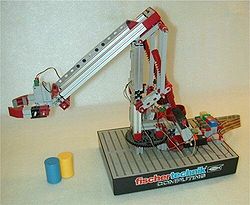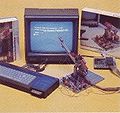Difference between revisions of "Fischertechnik Trainingsrobot"
From CPCWiki - THE Amstrad CPC encyclopedia!
| Line 21: | Line 21: | ||
* Interface for USB port (used on PCs) | * Interface for USB port (used on PCs) | ||
| − | === Parallel Printer Port === | + | === Parallel Printer Port Interface === |
| − | + | Designed for one-directional printer ports: Data is read via BUSY line (which data is to be read is selected via DATA lines) (details on how the data is transferred exactly are unknown?). | |
Printer Pin Interface Signal | Printer Pin Interface Signal | ||
Pin2 (Data Bit0) Load-out | Pin2 (Data Bit0) Load-out | ||
Revision as of 07:47, 7 April 2010
A robotic arm made by the German company Fischertechnik..
This robot was also produced for other 8bit computers of the era. (Commodore 64/VIC20 and the BBC micro)
The only difference was the interface.
The interface for the CPC (as well as newer RS232/USB versions) consists of:
- 8 single bit inputs ports (eg. for sensing when a robot-arm reached its end-position)
- 4 "bidirectional" ports (for motor control) (here "bidirectional" rather means "three-state-output" aka "forward/stop/backward")
- 2 analog inputs (eg. for temperature sensor)
Technical
Fischertechnik has built several interfaces:
- C64/VIC20 probably required a custom interface (?)
- Interface for one-directional printer port (used on PCs) (this might have been also used by CPC ?)
- Interface for RS232 port (used on PCs) (9600 baud, 8bit, no parity, 1 stopbit)
- Interface for USB port (used on PCs)
Parallel Printer Port Interface
Designed for one-directional printer ports: Data is read via BUSY line (which data is to be read is selected via DATA lines) (details on how the data is transferred exactly are unknown?).
Printer Pin Interface Signal Pin2 (Data Bit0) Load-out Pin3 (Data Bit1) load-in Pin4 (Data Bit2) Data-out Pin5 (Data Bit3) Clock Pin6 (Data Bit4) Trigger-x Pin7 (Data Bit5) Trigger-y Pin11 (Busy) Data/caunt-in
Reviews
The robot was reviewed in the danish magazine Amstradbladet 1986, Issue 3/4 (page 4-6)
Pictures
- Fischertechnik robot
Weblinks
http://www.fischer.de/ fischer group homepage





